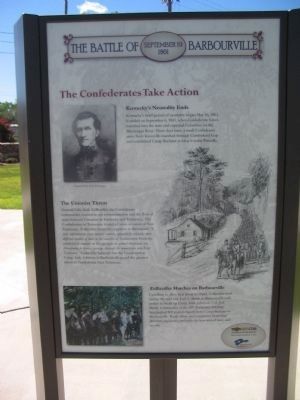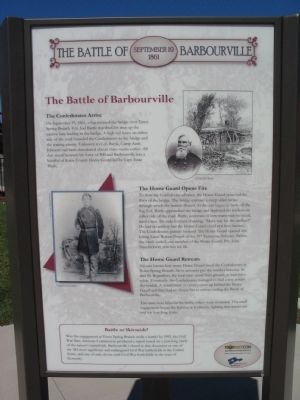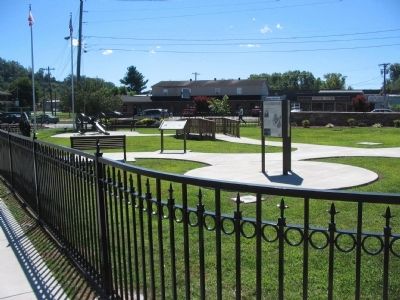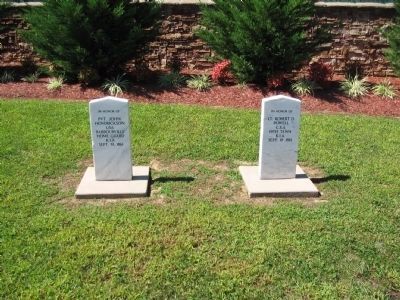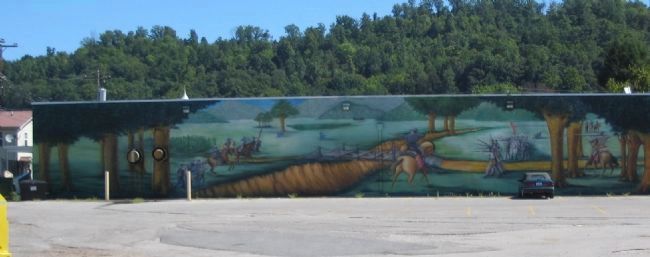Barbourville in Knox County, Kentucky — The American South (East South Central)
The Battle of Barbourville
September 19, 1861
— First Kiosk —
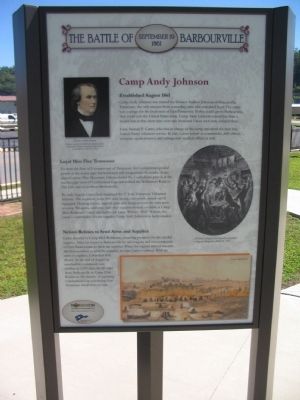
Photographed By Craig Swain, September 5, 2010
1. First Panel
The panel displays a portrait of Senator Andrew Johnson. In the center is an illustration depicting A Unionist meeting in East Tennessee as portrayed in Harper's Weekly magazine in March 1862. At the bottom is a depiction of Camp Andy Johnson.
Camp Andy Johnson
Established August 1861
Camp Andy Johnson was named for Senator Andrew Johnson of Greenville, Tennessee, the only senator from a seceding state who remained loyal. The camp was a refuge for the loyal men of East Tennessee. If they could get to Barbourville, the could join the United States army. Camp Andy Johnson existed less than a month but in that short time over one thousand Union men were enlisted there.
Lieut. Samuel P. Carter, who was in charge of the camp, mustered the men into United States volunteer service. In fact, Carter served as commander, drill officer, company quartermaster, and infrequently medical officer as well.
Loyal Men Flee Tennessee
To stem the flow of Unionists out of Tennessee the Confederates posted guards at the major gaps but loyal men still escaped into Kentucky. Some slipped across Pine Mountain. Others eluded the Confederate patrols at the smaller gaps west of Cumberland Gap and walked the Wilderness Road to Flat Lick and on north to Barbourville.
By early August, Carter had organized the 1st East Tennessee Volunteer Infantry. The regiment, some 800 men strong, was poorly armed and ill equipped. Hunting knives, squirrel guns and shotguns were the only arms in camp. Weapons, uniforms and other equipment were available at Camp Dick Robinson. Carter decided to ask Lieut. William "Bull" Nelson, the camp's commander, for the supplies Camp Andy Johnson so badly needed.
Nelson Refuses to Send Arms and Supplies
Carter traveled to Camp Dick Robinson, extracting promises for the needed supplies. After his return to Barbourville he sent wagons and two companies of East Tennesseans to fetch the supplies. When the wagons arrived not only did Nelson refuse to send the supplies, he kept Carter's soldiers. With no arms or supplies, Carter had little choice. At the end of August he marched his command, now swollen to 1,000 men, the 80 miles from Barbourville to Camp Dick Robinson. His dreams of capturing Cumberland Gap and freeing East Tennessee would have to wait.
(Second Panel):
The Confederates Take Action
Kentucky's Neutrality Ends
Kentucky's brief period of neutrality began May 16, 1861. It ended on September 6, 1861, when Confederate forces marched into the state and captured Columbus on the Mississippi River. Three days later, a small Confederate army from Knoxville marched through Cumberland Gap and established Camp Buckner at what is today Pineville.
The Unionist Threat
General Felix Kirk Zollicoffer, the Confederate commander, wanted to cut communication and the flow of arms between Unionists in Kentucky and Tennessee. The Confederates
in Tennessee feared a Union invasion of East Tennessee. Zollicoffer wrote his superiors in Richmond, "I have information from various sources, apparently reliable, that different bodies of men in the counties of Southeastern Kentucky, estimated to amount in the aggregate to several thousand, are ... threatening to force a passage through the mountains into East Tennessee." Zollicoffer believed that the Union men at Camp Andy Johnson in Barbourville posed the greatest threat to Confederate East Tennessee.
Zollicoffer Marches on Barbourville
Unwilling to allow that threat to stand, Zollicoffer took action. He sent Col. Joel A. Battle to Barbourville with orders to break up Camp Andy Johnson. Col. Joel Battle, commander of the 20th Tennessee Infantry, handpicked 800 men to march from Camp Buckner to Barbourville. Battle chose two companies from four different regiments, probably the best-armed men, and set out.
(Third Panel):
The Battle of Barbourville
The Confederates Arrive
On September 19, 1861, a fog covered the bridge over Town Spring Branch. Col. Joel Battle marched his men up the narrow lane leading to the bridge. A high rail fence on either side of the road funneled the Confederates to the bridge and the waiting enemy. Unknown to Col. Battle, Camp Andy Johnson had been abandoned almost three weeks earlier. All that stood
between his force of 800 and Barbourville was a handful of Knox County Home Guard led by Capt. Isaac Black.
The Home Guard Opens Fire
To slow the Confederate advance, the Home Guard removed the floor of the bridge. The bridge spanned a steep sided ravine, through which the branch flowed. As the sun began to burn off the fog, Col. Battle approached the bridge and deployed his soldiers on either side of the road. Battle, uncertain of how many men he faced, tried a ruse. He rode forward shouting, "Make way for the artillery!" He had no artillery but the Home Guard could not have known. The Confederates pushed forward. The Home Guard opened fire, killing Lieut. Robert Powell of the 19th Tennessee Infantry. Before the battle ended, one member of the Home Guard, Pvt. John Hendrickson, also lost his life.
The Home Guard Retreats
No one knows how many Home Guard faced the Confederates at Town Spring Branch. Most accounts put the number between 30 and 50. Regardless, the local men stood their ground, at least for a while. Eventually, the Confederates managed to find a way across the branch. A detachment of cavalry came up behind the Home Guard and they had no choice but to retreat, ending the Battle of Barbourville.
Two men were killed in the battle; others were wounded. This small engagement began the fighting in Kentucky, fighting in Kentucky, fighting that would not end for four long years.
Battle or Skirmish?
Was the engagement at Town Spring Branch really a battle? In 1992, the Civil War Sites Advisory Commission produced a report based on a year-long study of the nation's battlefields. Barbourville is listed in that document as one of the 384 most significant and endangered Civil War battlefields in the United States, and one of only eleven such Civil War battlefields in the state of Kentucky.
Topics and series. This historical marker is listed in this topic list: War, US Civil. In addition, it is included in the Former U.S. Presidents: #17 Andrew Johnson series list. A significant historical date for this entry is May 16, 1750.
Location. 36° 52.006′ N, 83° 53.136′ W. Marker is in Barbourville, Kentucky, in Knox County. Marker is at the intersection of Daniel Boone Drive (State Highway 11) and Cumberland Avenue (State Highway 2421), on the right when traveling west on Daniel Boone Drive. Located in the Battle of Barbourville Interpretive Park. Touch for map. Marker is in this post office area: Barbourville KY 40906, United States of America. Touch for directions.
Other nearby markers. At least 8 other markers are within walking distance of this marker. A different marker also named The Battle of Barbourville (here, next to this marker); a different marker also named The Battle of Barbourville (a few steps from this marker); First House in Kentucky (about 500 feet away,
measured in a direct line); Knox County Veterans Memorial (approx. 0.2 miles away); Flem D. Sampson (1875-1967) (approx. 0.2 miles away); Daniel Boone (approx. 0.2 miles away); Union College (approx. 0.3 miles away); The Minton Memorial (approx. 0.3 miles away). Touch for a list and map of all markers in Barbourville.
Credits. This page was last revised on June 16, 2016. It was originally submitted on September 16, 2010, by Craig Swain of Leesburg, Virginia. This page has been viewed 1,354 times since then and 65 times this year. Photos: 1, 2, 3, 4. submitted on September 16, 2010, by Craig Swain of Leesburg, Virginia. 5, 6. submitted on September 17, 2010, by Craig Swain of Leesburg, Virginia.
